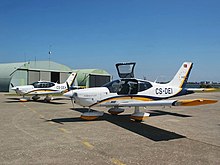São Jacinto Air Base
| Aeródromo Municipal de Aveiro São Jacinto Airport |
|||||||||||
|---|---|---|---|---|---|---|---|---|---|---|---|

Two Socata TB-200GTs at Aveiro
|
|||||||||||
| Summary | |||||||||||
| Airport type | Public | ||||||||||
| Operator | Câmara Municipal de Aveiro | ||||||||||
| Serves | Aveiro | ||||||||||
| Elevation AMSL | 26 ft / 8 m | ||||||||||
| Coordinates | 40°39′15″N 008°44′37″W / 40.65417°N 8.74361°W | ||||||||||
| Runways | |||||||||||
|
|||||||||||
São Jacinto Airport, officially designated Aveiro Municipal Aerodrome (Portuguese: Aeródromo Municipal de Aveiro), is an aerodrome near the city of Aveiro in Portugal. It is located on a peninsula, between the Atlantic Ocean and the Vouga River estuary, in the parish of São Jacinto, near to the harbour of Aveiro, as well as the Costa de Prata (Silver Coast) beaches. It has a single runway in the 17/35 direction and a relatively large apron and has been operated in the past by all branches of the Portuguese Armed Forces. It is home to an air club, Aeroclube de Aveiro, but is currently closed to civilian traffic due to lack of certification.
The airfield dates back to World War I, with the creation of an anti-submarine hydroplane base by the French Naval Aviation established a base on April 1, 1918. With the end of the war the base was integrated into the Portuguese Naval Aviation and in 1927 the Admiral Gago Coutinho Naval Aviation School (Portuguese: Escola de Aviação Naval Almirante Gago Coutinho) was installed at its facilities. A runway was then constructed in 1937 to allow the operation of conventional aircraft from the base.
In 1953, with the creation of the Portuguese Air Force the previous year, the base is transferred to that branch. In 1977 the air base is deactivated and the base's garrison is then used by the Air Force's airborne troops as Airborne Troops Operational Base No. 2 (Portuguese: Base Operacional de Tropas Pára-quedistas Nº2, BOPT2) and its aviation facilities are designated as Maneuvers Airfield No. 2 (Portuguese: Aeródromo de Manobra Nº 2, AM2) until their deactivation in 1992 as an independent unit. With the integration of the airborne troops in the Army the base was re-designated S. Jacinto Military Area (Portuguese: Área Militar de S. Jacinto, AMSJ).
...
Wikipedia
